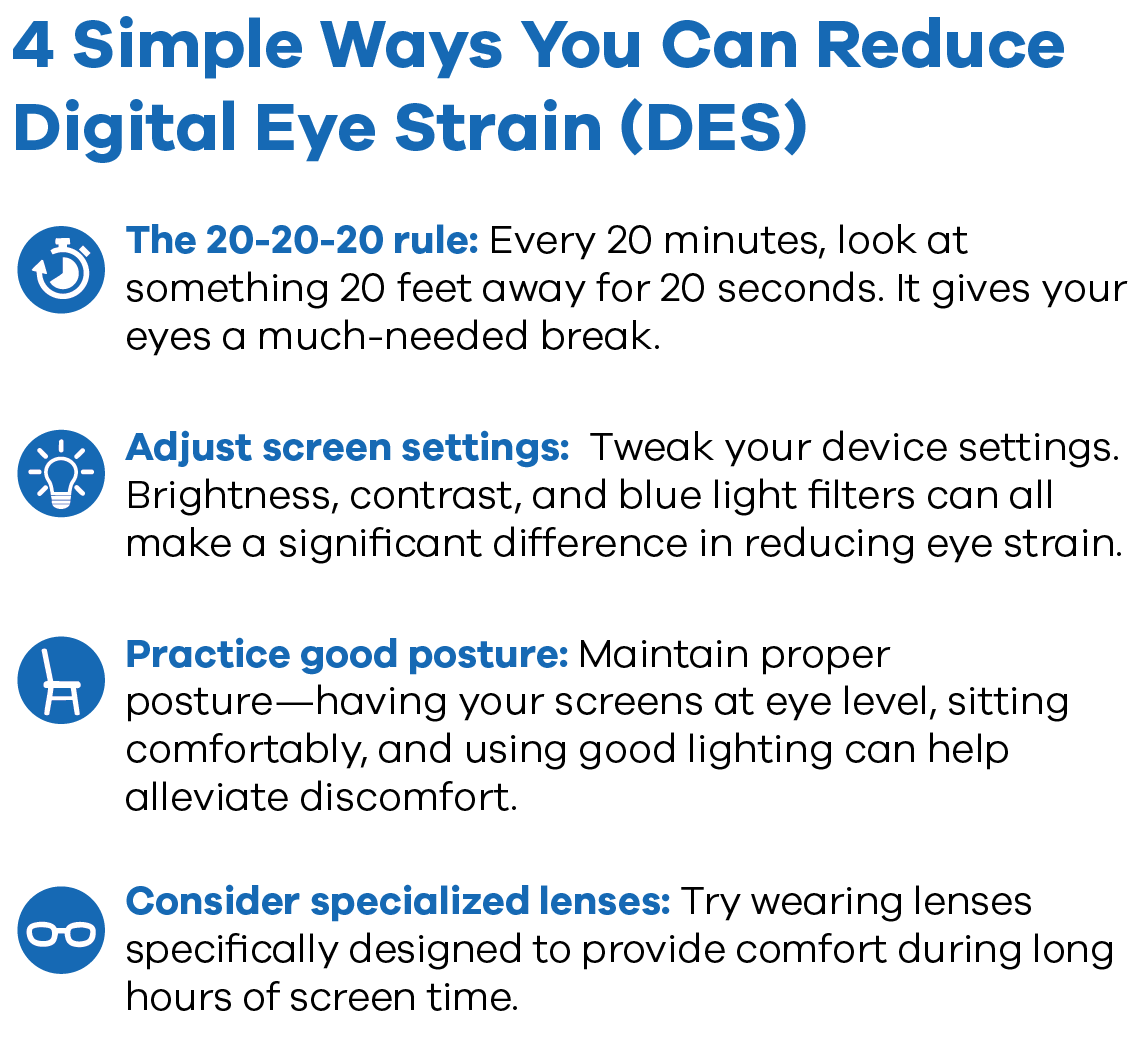We spend hours in front of screens—for work, leisure, or social connection. Many people experience symptoms like dry eyes, headaches, and blurred vision and may fail to connect these discomforts with their screen habits. As an Eye Care Professionals (ECP), you have an opportunity to educate your patients about Digital Eye Strain (DES) and recommend effective solutions that boost their comfort and productivity.
What is DES?
Digital Eye Strain, or DES, is a blanket term for the discomfort many people experience after too much screen time. It can stem from several factors, including extended periods of close-up focus, prolonged screen exposure, and blue light emitted from digital devices. These issues are becoming more common, so it’s essential to address them head-on.
Common DES symptoms
When it comes to DES, patients may experience several symptoms, such as:
- Eye fatigue: That tired sensation in your eyes that seems to creep in after a few hours of staring at a screen.
- Headaches: Often pop up due to prolonged focus and poor lighting.
- Blurred vision: A temporary loss of sharpness, especially noticeable after long stretches of screen use.
- Dry eyes: A common result of reduced blinking during intense screen time.
- Neck and shoulder pain: Poor posture while using devices can lead to muscle strain.
Recognizing these signs is key for both you and your patients, as it starts an important conversation about their daily screen habits.
Your role as an ECP: educator and guide
Many people aren’t aware that their eye symptoms could be linked to their digital habits. You can help them connect the dots between their screen use and their discomfort. A question like, “How much time do you spend in front of screens each day?” can help you gather valuable insights and guide them toward helpful solutions.
Practical tips for reducing DES
The good news is that your patients can take steps to reduce their DES and improve their comfort at work. To help, we’ve provided the following graphic that you can share on your social media channels or website:

4 Simple Ways You Can Reduce Digital Eye Strain (DES):
- The 20-20-20 rule: Every 20 minutes, look at something 20 feet away for 20 seconds. It gives your eyes a much-needed break.
- Adjust screen settings: Tweak your device settings. Brightness, contrast, and blue light filters can all make a significant difference in reducing eye strain.
- Practice good posture: Maintain proper posture—having your screens at eye level, sitting comfortably, and using good lighting can help alleviate discomfort.
- Consider specialized lenses: Try wearing lenses specifically designed to provide comfort during long hours of screen time.
HOYA technologies to combat DES
When it comes to combating DES, HOYA has several innovative lens technologies available for your patients.
Here are some options you can discuss:
Many professionals spend most of their days glued to screens working on multiple monitors, reading reports, or attending video conferences. iD WorkStyle® 3 is a specialized occupational lens designed to provide optimized vision for those who rely on digital screens throughout their workday.
What makes iD WorkStyle® 3 stand out is its highly customized design that ensures visual comfort in specific working distances. Whether someone is switching between a laptop, tablet, and desktop monitor, or referencing physical documents while working at a computer, iD WorkStyle® 3 provides an effortless viewing experience, reducing the need for excessive head movements or strain.
Long screen hours are becoming an increasing issue among students and younger adults. The younger generation is at higher risk of DES due to the extended time they spend on screens. Sync III® lenses are designed to provide relief from digital fatigue, making them an excellent choice for students and professionals alike.
Sync III® lenses feature an enhanced single-vision design with a slight boost in power, which helps the eyes relax during near work. This reduces the effort required for focusing, especially during long screen sessions. Patients experiencing symptoms like tired eyes or, headaches might find significant relief with this technology.
Blue light from screens is a widely discussed topic in digital eyewear. HOYA’s Recharge® treatment is a blue light attenuating solution designed to reduce digital eye fatigue without interfering with natural vision.
What does "attenuating" blue light really mean? While some products on the market claim to “block” blue light, there is no scientific evidence to back these claims. Instead, Recharge® helps manage blue light exposure in a way that reduces strain while maintaining color accuracy. Unlike aggressive blue light filters that can distort colors or give a yellowish tint, Recharge® is designed to provide a more natural viewing experience while relieving eye fatigue and improving visual comfort.
Glasses as a key part of daily life
In a world where screens dominate our daily routines, position specialized eyewear as a must-have rather than an afterthought. Encourage patients to consider glasses designed for digital use as their primary pair. After all, the right glasses can help improve their comfort and performance during screen time. Make sure to discuss managed vision care benefits that can help make this investment more accessible.
Give your patients a comfortable digital experience
DES is a growing concern that's affecting more people each year. As an ECP, you are at the forefront of addressing this issue. You can play a powerful role in educating your patients about their eye health and enable them to make informed decisions about their digital habits.
For more information, contact your HOYA Business Consultant for further assistance.
